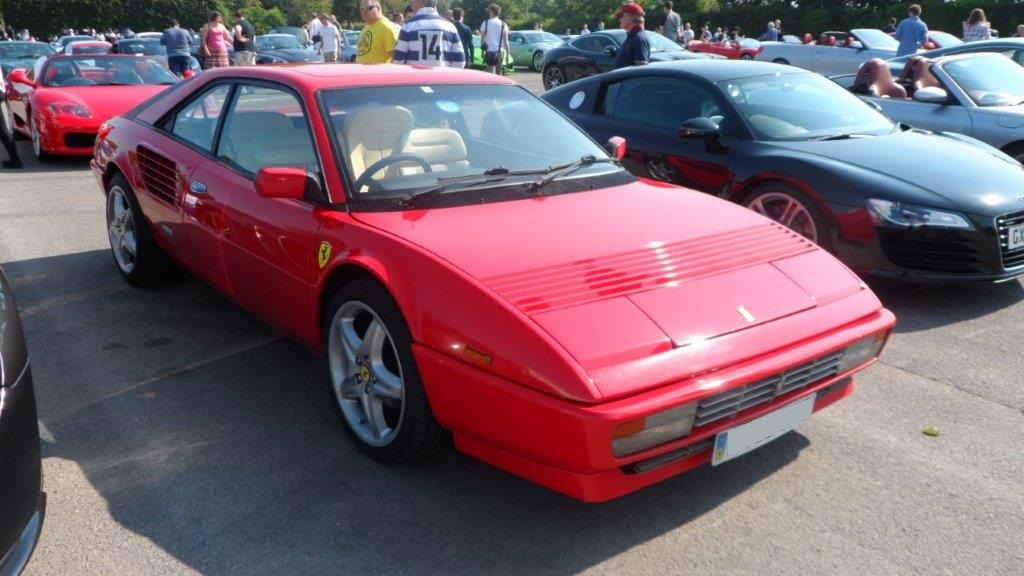-
Insurance
InsuranceAbout our productsLearn about insuringGet a quote Get current values, historical values, model history and more.
-
Valuation
ValuationHagerty valuation toolLook up a vehicle value Get current values, historical values, model history and more.
-
Events
EventsHagerty official eventsHagerty ClubhouseEvent calendar
-
Entertainment
EntertainmentMore to explore
- Portal login
1983 Ferrari Mondial
QV Coupe 2.9 L
Vehicle values by condition
Fair
Condition 4
£18,900
#4 cars are daily drivers, with flaws visible to the naked eye. The chrome might have pitting or scratches, the windshield might be chipped.
Good
Condition 3
£24,100
#3 cars could possess some, but not all of the issues of a #4 car, but they will be balanced by other factors such as a fresh paint job or a new, correct interior.
Excellent
Condition 2
£29,600
#2 cars could win a local or regional show. They can be former #1 cars that have been driven or have aged. Seasoned observers will have to look closely for flaws.
Concours
Condition 1
£45,400
#1 vehicles are the best in the world. The visual image is of the best car, unmodified, in the right colours, driving onto the lawn at the finest concours.
Insurance premium for a
1983 Ferrari Mondial QV Coupe 2926
valued at £24,100
£246.61
/ year*
History of the 1982 - 1985 Ferrari Mondial

1982 - 1985 Ferrari Mondial
The Pininfarina-designed Ferrari Mondial was introduced in 1980 and remained in production until 1993. It is a 2+2 sports car available as both coupe and cabriolet. The mid-mounted V-8 engine drives the rear wheels through a 5-speed gearbox.
The car was launched as the Ferrari Mondial 8 in coupe only form at the 1980 Geneva Motor Show and was intended to be a “usable” Ferrari. The transversely mounted 2.9 litre V-8 with its 5-speed gearbox mounted under the engine are shared with the Ferrari 308. The chassis is unusual in being a box section space frame with the steel outer panels produced by Scaglietti. The suspension is independent all round by double wishbones and braking is by vented disc front and back.
After an initial lacklustre response from the motoring press the concerns regarding the Ferrari Mondial’s performance were addressed by the introduction of the Quattrovalvole (QV) in 1982 upping the power by 26 bhp. The cabriolet joined the coupe in 1983 and had the rear seats moved closer to the car’s centreline.
A further gain in performance came along in 1985 when the V-8 gained an increase in both stroke and bore with the name changing to Ferrari 3.2 Mondial to reflect the new capacity. The body styling was also subtly updated, including a move to body-coloured bumpers.
The most radical alteration during the Mondial’s life came in 1989 with the introduction of the Ferrari 348’s longitudinally mounted engine and its rear mounted transverse gearbox. This dropped the centre of gravity for the car and the new name “Ferrari Mondial t” referenced the layout. A semi-automatic electronic clutch, used with the standard gearlever, was also offered as an option.
The first incarnation of Ferrari Mondial has a fuel injected 2927cc, all-alloy V-8 engine with 4 overhead cams sat above the 5-speed gearbox. The Quattrovalvole kept this capacity but gained its power increase through the combination of an improved combustion chamber and two extra valves per cylinder. The engine and gearbox configuration remained constant during the increase to 3185cc but the 3405cc engine is mounted longitudinally. The transverse gearbox of the Mondial t still has 5 gears but in this case power is fed to the rear wheels via a ZF limited-slip differential.
Despite the Ferrari Mondial’s remit to be “useable” it is still a mid engine supercar with all the compromises that are to be expected from this. Consequently although it is a 4-seater the rear seats are only really suitable for transporting children. The boots (front and rear) are small by conventional standards, but of a reasonable size when compared to other Ferraris and even Porsches of the time. The payoff is sharp, well balanced handling and the noise from the flat plane crank V-8s. The car is highly stable at speed with the lower mounted engine of the Ferrari Mondial t giving it an edge through the corners.
As with any Ferrari a good service history is an important consideration when buying although a good home mechanic should have the skills to undertake some servicing work. The engines and drive trains are shared with the 308 and 328 so mechanical spares are readily available, unlike parts of the trim. As with most Ferraris of this era poor electrics and rust are a problem. Corrosion in the front wings and windscreen surround are of particular concern along with sills and door bottoms. Galvanising was introduced in 1984. The metric tyres can be expensive to source.
Early poor reviews have blighted the image all Ferrari Mondials since its launch but the Mondial 8 was hardly a bad car and the Quattrovalvole addressed the main issues. However in all guises some still look down on it compared to its more glamorous two-seat stable mates. Later cars are preferred with cabriolets fetching a premium over the coupes. The Mondial 3.2 is generally seen as being a better car than the Mondial t.
A BMW M5 E28 will offer not dissimilar performance with four full-size seats whereas the Townsend “wedge” Lagonda offers another four- seat option with supercar looks.
Hagerty Newsletter
Get your weekly dose of car news from Hagerty UK in your inbox

ADVERTISEMENT